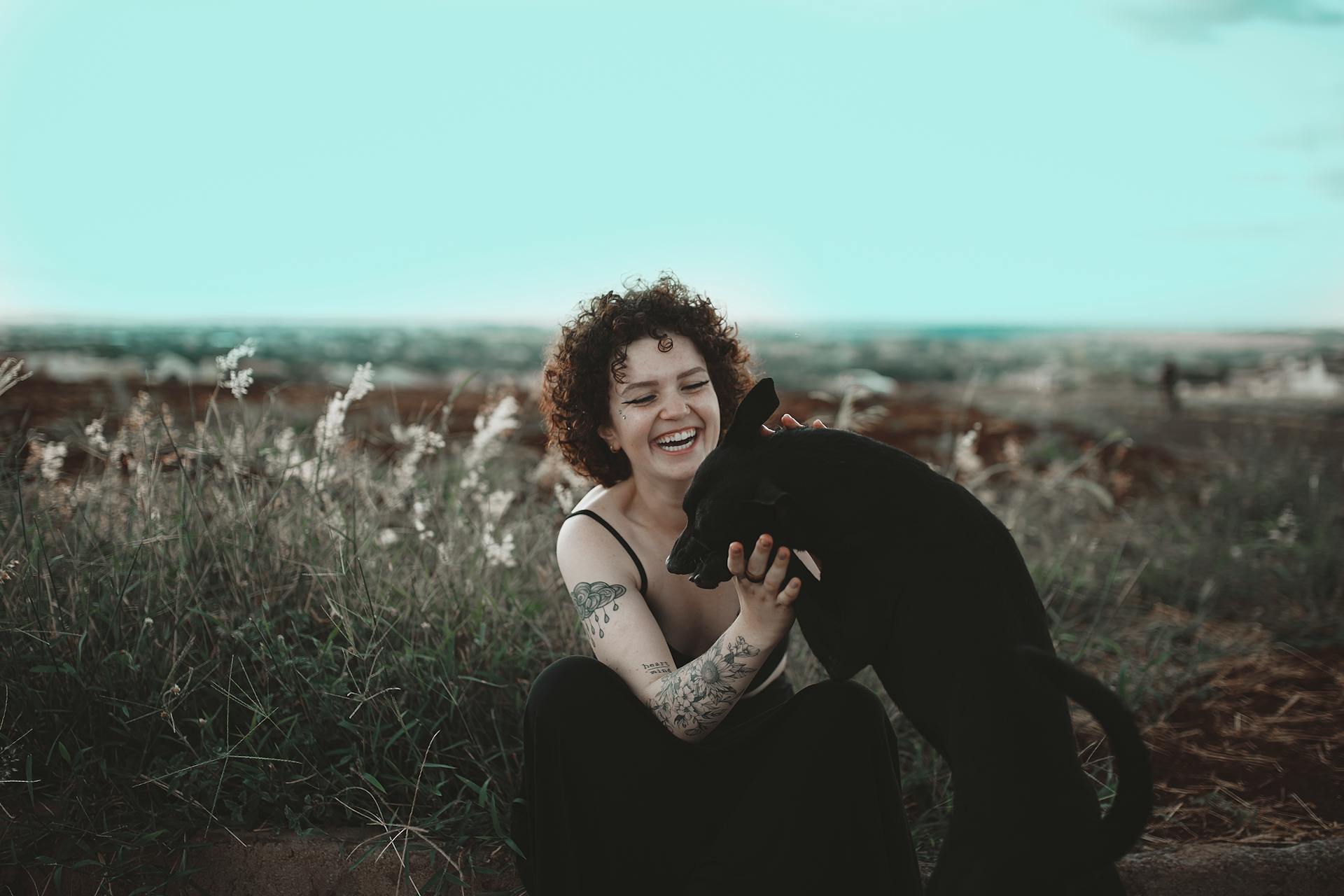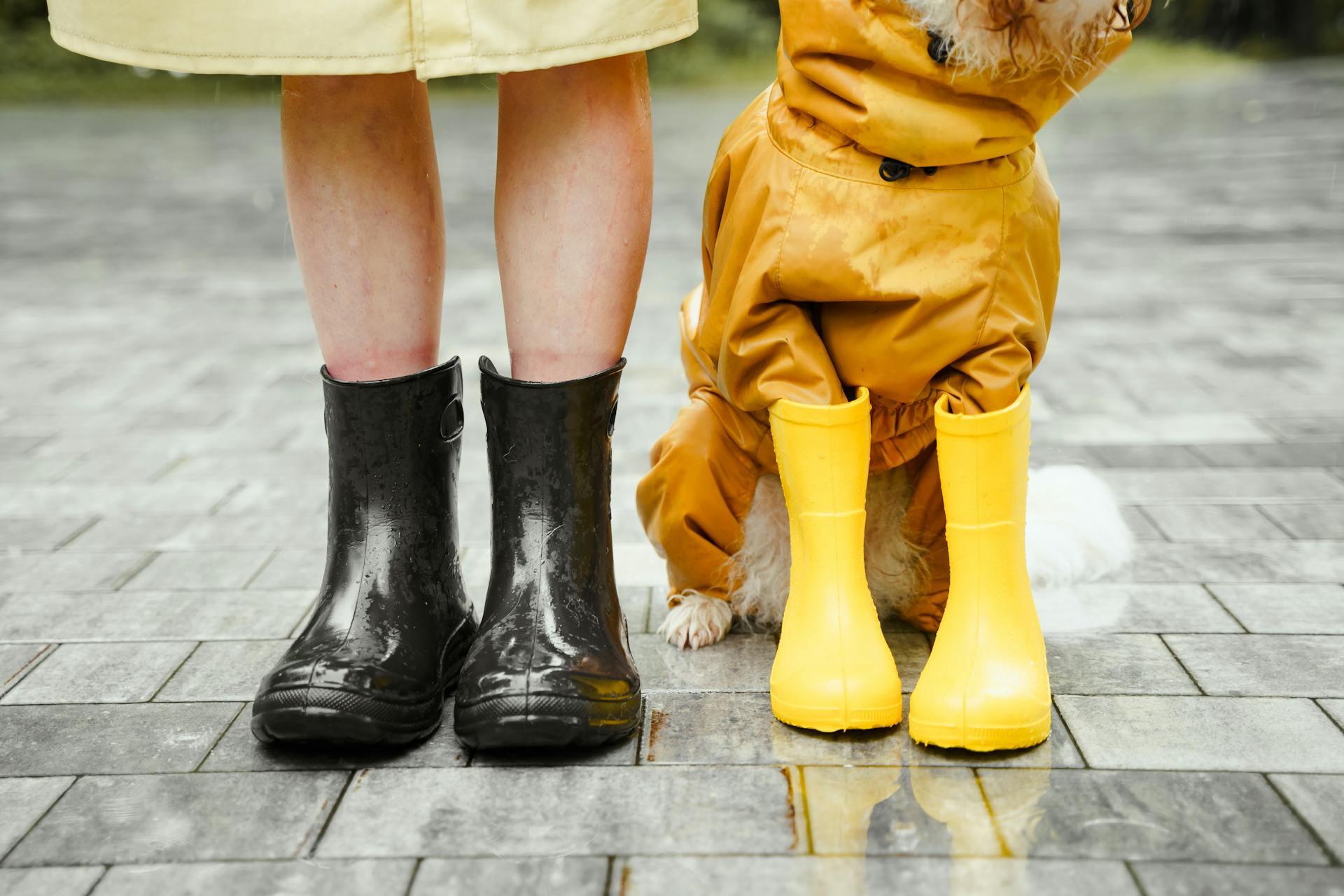
The Full Grown Black Boerboel is a magnificent breed, known for its striking appearance and loyal nature.
They typically weigh between 110-145 pounds and stand 24-27 inches tall at the shoulder.
Their short, smooth coat requires minimal grooming, making them a great choice for busy owners.
Black Boerboels are intelligent and trainable, but can be strong-willed at times, requiring consistent and patient training.
Boerboel Breed
The Boerboel breed is a big dog, built strong with good muscle development and is buoyant in its movements.
They originated from dogs brought by British, French, and Dutch settlers to South Africa, and were later cross-bred with English long-legged Bulldog and Bullmastiff in the 1950s.
The name Boerboel is Afrikaans for farm dog, which suits its purpose well. It's a powerful and muscular dog that's perfect for guarding property.
Their short, dense, sleek coat is easy to groom, and they only need a monthly bath and occasional dip to keep them looking their best.
See what others are reading: All Black Boerboel
Boerboels have a strong instinct to guard and will not respond well to strangers, so a well-fenced yard is a must.
They're not apartment dogs and need a yard to run in to stay fit and healthy.
Their head expresses their character, with a short, square muscular face that's broad and flat at the top.
Their eyes are beautiful, horizontally set and shades of brown, often darker than the pelt color.
Their muzzle is black with wide large nostrils, and the nasal bone is broad and tapers slightly to the front.
Boerboels have very strong jaws and well-developed white teeth, with a scissors bite.
They have a strong and muscular neck, straight back, and muscular chest.
Their short tail is attached high to the body, and they have perfectly vertical front legs and hind paws that are slightly smaller than the front paw.
When alert, the dog has moderate wrinkles on the forehead.
Regular exercise is important for Boerboels, and they'll happily sit by your side all day, but they need active exercise to stay fit and healthy.
They love to play with the family, especially fetching a ball, and will probably end up puncturing it with their strong teeth, but they'll play just as happily with a flat ball as an inflated one.
Temperament
The Boerboel temperament is a unique blend of loyalty and protectiveness. They are a dominant breed that takes their duties very seriously.
Boerboels are naturally protective of their pack, which includes human and animal members. This means they can be wary of strangers and may not immediately warm up to new visitors.
With proper introduction and socialization, Boerboels can learn to accept new people and animals into their pack. However, they still need a strong pack leader to guide them and establish clear boundaries.
Boerboels are highly intelligent and trainable, but they require consistent training and socialization from an early age. Without this, their protective instincts may become too strong, leading to difficulties in certain situations.
As a breed, Boerboels are loving with children and family, but may be aloof with strangers. This self-assured aloofness is a natural trait that should not be faulted.
With the right training and care, Boerboels can make wonderful family pets. However, they are not a breed for everyone, and potential owners should carefully consider their decision before bringing one home.
Physical Characteristics
The full grown black Boerboel is a stunning sight to behold, with a strong bone structure and well-developed musculature. Its body is slightly longer than tall, being approximately 10 to 15 percent longer than its height at the withers.
The torso of a full grown black Boerboel is impressive, with adequate width and depth, a level topline, and a defined muscular ridge above the withers. The ribcage is well sprung, with maximum volume.
The skin on a full grown black Boerboel is relatively loose-fitting and flexible, without major wrinkles, and shows dark pigmentation. The coat is sleek, short, smooth, and dense, making it a pleasure to look at.
Characteristics
The Boerboel's protective nature is still highly valued today, making it a popular choice for farmers and urban communities alike.
Their calm and stable composure is a key characteristic of the breed, and it's essential to preserve this unique identity and quality.
The Boerboel is a utilitarian farm dog, suitable for various working and performance tasks, as well as companionship.
Temperament, biddability, and working structure should be emphasized over cosmetic or conformational shortcomings.
The Boerboel has a strong protective instinct and should be discerning and accepting of friendly strangers with proper introductions.
They can remain reserved and aloof, but this doesn't mean they're not a great family companion.
Disqualifications for the breed include viciousness or extreme shyness.
The Boerboel's lips should not extend below the lower jaw, and their bottom lip should be moderately tight without excessive or open jowls.
Shades of brown are preferred for the Boerboel's coat, with a darker tone being more desirable than a lighter one.
Head
The Boerboel's head is a distinctive feature, characterized by its blocky, broad, deep, square, and muscular shape, which is in proportion to the rest of the body.
The head is fairly free of wrinkles when the dog is relaxed, but moderate wrinkles are present when it's attentive.
A well-marked stop is a defining feature of the Boerboel's head, and it's not too steep.

The muzzle blends smoothly with the skull, without any areas of rapid indentation, and is broad and deep, tapering slightly to the front.
The nasal bone measures approximately one-third the total length of the head.
The length of the top of the skull is relatively the same as the length of the nasal bone, with a maximum ratio of 1:1.5.
The Neck
The neck is a distinctive feature of this breed, gradually increasing in width from the head to the shoulder.
It's of medium length, powerful, and has an arched crest.
The head and neck don't show excessive skin, which is a notable characteristic of this breed.
The scruff may be loose, and the dewlap may be noticeable, but not excessive.
The skin is tight across the sternum, giving a sleek appearance.
General Appearance
The Boerboel is a large dog with strong bone structure and well-developed musculature.
Its impressive demeanor is created by a combination of conformation, carriage, confidence, and powerful movement. The skin on the body is relatively loose-fitting and flexible, without major wrinkles.
The body is slightly longer than tall, being approximately 10 to 15 percent longer than the height measured at the withers. This unique proportion gives the Boerboel a balanced appearance.
The Boerboel is a well-balanced dog with all body parts in proportion to each other. Its appearance exudes the immense power of which they are capable.
The Boerboel's appearance is distinguishable by sex, and it exhibits a fine balance between intimidation and athletic working abilities and stamina.
Tail
The tail of the Boerboel is a natural extension of the spine, set fairly high and well-covered with hair. It's a distinctive feature of the breed.
Long tails are a common sight, tapering to the end and reaching down to the hocks or a little below. This is a characteristic of many Molossers, with their whip-like tails being a notable exception.
The natural tail of the Boerboel is quite variable from dog to dog, due to its genetic diversity. However, most Boerboels have long and tapering tails.
Docked tails are traditionally docked at the third or fourth caudal vertebrae. This is a common practice in the breed.
The tail set is more important than length, so even if a Boerboel has a shorter tail, it's still considered a desirable trait if it's set correctly.
Coat & Skin
The coat is sleek, short, smooth and dense. I've seen many animals with coats like this, and they always look so well-groomed.
The skin is thick, loose (but not excessively so), and shows dark pigmentation. This is a great example of how the animal's physical characteristics can be both functional and aesthetically pleasing.
Height
The Boerboel's height is a crucial aspect of its overall balance and conformation. Males should ideally be around 26 inches tall.
One of the key factors to consider is that males should be no shorter than 23 inches in height. Eliminating Faults: Males less than 23 inches in height are not ideal.
Females, on the other hand, should be at least 21 inches tall to maintain the breed's overall balance and conformation.
Health and Gait
The full-grown black Boerboel is a majestic sight to behold, but its powerful physique requires careful consideration to ensure its health and gait are top-notch.
A Boerboel's movement is characterized by a powerful, purposeful, buoyant, and fluent gait, with comfortable reach in front and rear.
Propulsion must come from the rear without crabbing or twisting, and the legs should be retained as a straight column both walking and trotting.
Limited mobility must be severely penalized, and absolute soundness and freedom of movement is essential for this breed.
Hindquarters
The hindquarters of a dog are a crucial aspect of their overall health and gait. The hindquarters are well angulated, well-muscled and deep and broad, especially in bitches.
A broad croup is essential, and it should be of good length and set slightly sloping. This angulation is vital for proper movement and flexibility.
The upper thighs must be broad, deep and muscular, with substantial thickness when viewed in profile and from the rear. This muscle mass is crucial for power and endurance.
Correctly angulated lower thighs are also essential, with equal length to the upper thigh and well-developed musculature down to the hock. This ensures smooth and efficient movement.
The hocks must be strong and sturdy, of medium length, in proportion to the rest of the leg. They should be parallel and in line with the rest of the leg when viewed from the rear.
The rear pasterns are relatively short, strong and of adequate girth. They should be parallel with each other when viewed from the rear.
Removal of rear dewclaws is preferred, but not mandatory.
Health
Maintaining a healthy weight is crucial for a normal gait. Excess weight can put additional stress on joints, leading to pain and discomfort.
Walking regularly can help strengthen muscles and improve balance, reducing the risk of falls. For example, walking just 30 minutes a day can make a significant difference.
Proper footwear is also essential for a healthy gait. Wearing shoes with good arch support and cushioning can help reduce the risk of injuries and discomfort.
As we age, our gait can change due to natural wear and tear on joints. This can lead to a slower and more labored gait, making everyday activities more challenging.
Gait

The gait of a Boerboel is a key aspect of their overall health and well-being. The movement is described as powerful, purposeful, buoyant, and fluent.
A comfortable reach in front and rear is essential, and propulsion must come from the rear without crabbing or twisting. This means that the legs should move in a straight line, both when walking and trotting.
The legs must be retained as a straight column, with elbows, pasterns, and hocks remaining firm. This is crucial for maintaining proper movement and preventing injuries.
A stable topline is also vital, without roaching or drooping in the middle or with excessive body roll. Limited mobility is severely penalized, emphasizing the importance of a healthy gait.
Absolute soundness and freedom of movement are essential for a Boerboel's overall health and well-being.
Featured Images: pexels.com


